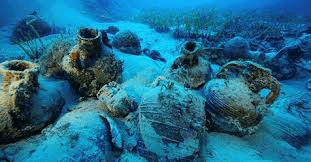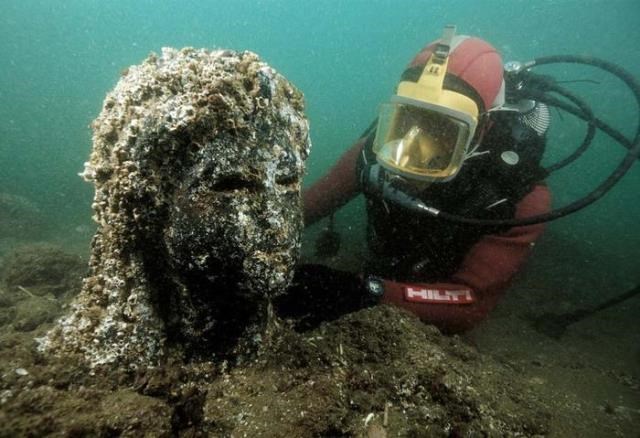Forgotten Maritime History: Shipwrecks and Submerged Relics
Maritime history is a captivating field that delves into the rich and diverse stories of human interaction with the vast oceans. From ancient civilizations to modern societies, the relationship between humanity and the sea has shaped cultures, economies, and even political landscapes. As we explore this intriguing history, it becomes clear that shipwrecks and submerged relics hold a special place in understanding our maritime past.
Throughout the annals of time, shipwrecks have left their mark on history, serving as a bridge between the past and present. These underwater time capsules offer invaluable insights into the lives of those who sailed the seas centuries ago. By studying shipwrecks, we gain a deeper understanding of seafaring technologies, navigation techniques, and the challenges faced by those who braved the open ocean.
Furthermore, submerged relics play a crucial role in preserving and documenting our collective heritage. These relics encompass an astonishing range of artifacts, including ancient vessels, cargo, tools, and even personal belongings. Each piece tells a unique story, shedding light on different aspects of maritime life. By carefully studying and preserving these relics, we gain valuable knowledge about trade networks, cultural exchange, and technological advancements throughout history.
As we unravel the mysteries concealed in the depths of the ocean, it is essential to acknowledge the significance of shipwrecks and submerged relics in unraveling our past. Through these tangible links to history, we gain a profound appreciation for the ingenuity, resilience, and cultural diversity of our ancestors. Join us as we dive deep into the forgotten maritime history, exploring the tales waiting to be discovered beneath the waves.
Table of Contents
Historical Background of Shipwrecks
Shipwrecks have played a significant role throughout history, acting as both tragic events and valuable sources of knowledge about the past. From the ancient civilizations to the present day, shipwrecks have adorned the ocean floors with their stories and submerged relics. These maritime accidents have occurred for various reasons, including storms, collisions, and wars, leaving behind a diverse range of vessels and artifacts.
Throughout the centuries, shipwrecks have acted as time capsules, preserving cultural heritage and artifacts that help us understand the ways of life of different societies. Exploration of these underwater sites has unveiled ancient vessels, valuable cargo, and even personal belongings, offering a glimpse into the past. Such discoveries have shed light on trade routes, maritime technologies, and the daily lives of sailors and passengers.
One prominent shipwreck that stands out in history is the RMS Titanic, which sank in 1912 after hitting an iceberg. This tragic event not only claimed lives but also sparked extensive public intrigue. The subsequent exploration and documentation of the Titanic’s remains have provided invaluable insights into the luxurious lifestyles of the Edwardian era and the flaws in maritime safety practices of the time.
Another noteworthy vessel is the Vasa, a 17th-century warship that sank on its maiden voyage in 1628. The remarkably well-preserved wreck of the Vasa has offered historians a detailed understanding of naval architecture, craftsmanship, and the military strategies employed during that era. These shipwrecks, among many others, have become dots on the historical timeline, each contributing to our collective understanding of maritime history.
The significance of shipwrecks lies not only in the preservation of cultural heritage but also in their ability to provide tangible links to the past. Through careful exploration and excavation, archaeologists and researchers can piece together the puzzle of our seafaring ancestors. They can uncover artifacts, study their construction techniques, and delve into the narratives of those who once sailed the seas.
This historical background of shipwrecks highlights the importance of these submerged relics in understanding our maritime past. From ancient ships carrying precious cargo to modern vessels that met a tragic fate, each shipwreck is a gateway to a forgotten era. By studying these artifacts and preserving them for future generations, we can unravel the mysteries of the sea and gain a deeper appreciation for the intricate tapestry of our maritime history.
Submerged Relics: Preserving the Past
The world beneath the ocean’s surface holds a treasure trove of history, with submerged relics providing glimpses into ancient civilizations and lost maritime adventures. These relics encompass a wide range of items, including ancient vessels, valuable cargo, and a myriad of other artifacts. The preservation and recovery of these submerged relics present unique challenges that require careful planning and innovative techniques.
Preserving these relics is of utmost importance as they offer invaluable insights into our past. For centuries, maritime trade and exploration shaped the course of human history, and shipwrecks stand as physical records of these significant events. Through the recovery of submerged relics, archaeologists and historians can piece together the stories of long-forgotten cultures and understand the intricate networks of maritime trade.
However, preserving these relics is no easy task. The harsh underwater environment poses numerous challenges, including the destructive forces of currents, tides, and marine life. Furthermore, the sheer depth and remoteness of some sites make it difficult to access and excavate these precious remains. Yet, advancements in underwater excavation techniques and the use of specialized equipment have enabled successful preservation projects worldwide.
One such notable endeavor is the excavation of the Antikythera shipwreck off the coast of Greece. Discovered in 1900, this ancient Roman ship carried a treasure trove of artifacts, including statues, pottery, and the world-famous Antikythera mechanism, an ancient analog computer. Through meticulous excavation and conservation efforts, this shipwreck has yielded a wealth of knowledge about ancient trading routes and technology.
Another remarkable project is the discovery and preservation of the Vasa shipwreck in Stockholm, Sweden. This 17th-century warship, known for its elaborate ornamentation and historical significance, was remarkably well-preserved due to the unique brackish water environment of the Baltic Sea. Through careful excavation and innovative preservation techniques, the Vasa and its accompanying artifacts have been able to be showcased and admired by millions of visitors at the Vasa Museum.
These successful preservation projects serve as inspiring examples of how the delicate balance between excavation, conservation, and public display can be achieved. By investing in the expertise and resources required to preserve and recover submerged relics, we not only honor the legacy of the past but also create a lasting connection between present and future generations.
In conclusion, the exploration and preservation of submerged relics play a pivotal role in understanding our maritime history. The range of artifacts recovered from shipwrecks offers a window into the past, shedding light on ancient civilizations, trading routes, and technological advancements. While the challenges of preserving and recovering these relics are significant, successful projects such as the Antikythera shipwreck and the Vasa provide inspiration for future endeavors. As we continue to unlock the secrets held beneath the waves, it is imperative that we recognize the importance of these relics, ensuring their conservation and promoting public awareness of our underwater cultural heritage.
Shipwreck Archaeology: Unveiling the Secrets
Shipwreck archaeology is an intriguing field of study that enables us to uncover the secrets of the past through the examination of sunken vessels. This discipline plays a crucial role in understanding our maritime history and allows us to gain insights into the lives and experiences of those who once traversed the seas.
Methodologies and Techniques Used in Underwater Archaeology
In shipwreck archaeology, various methodologies and techniques are employed to explore and document submerged wrecks. One widely used method is remote sensing, which includes the use of sonar technology and underwater robots to survey large areas for potential shipwrecks. This approach helps to identify and locate archaeological sites, maximizing efficiency in exploration efforts.
Once a shipwreck is identified, underwater archaeologists dive to the site and undertake meticulous documentation and excavation processes. Photogrammetry is commonly used to create precise 3D models of the wreck, allowing researchers to analyze and study the structure without disturbing it. Furthermore, the retrieval of artifacts and the careful recording of their locations on the wreck are key components of the archaeologists’ work.
Notable Discoveries and Contributions to Maritime History
Over the years, shipwreck archaeology has revealed numerous fascinating discoveries that have significantly enhanced our knowledge of maritime history. One such notable discovery is the wreck of the RMS Titanic, which sank in 1912. The exploration of this tragic shipwreck has provided invaluable insights into the luxurious lifestyle of the early 20th century, as well as the technological advancements of the time.
Another remarkable find is the Antikythera Mechanism, a complex ancient Greek device discovered in a shipwreck off the coast of Antikythera. The mechanism, believed to be an astronomical calculator, has shed light on the advanced scientific knowledge of the ancient world and challenged our previous understanding of ancient technology.
Through shipwreck archaeology, we have been able to uncover significant artifacts, such as cultural relics, pottery, navigational instruments, and even human remains. These findings contribute to our understanding of trade networks, ship construction techniques, and the daily lives of sailors and passengers, providing a unique window into the past.
In conclusion, shipwreck archaeology enables us to unveil the secrets hidden beneath the sea’s surface and explore the remnants of our maritime history. By utilizing various methodologies and techniques, researchers can make notable discoveries that add to our understanding of the past. Through these endeavors, we continue to preserve, study, and appreciate the invaluable cultural heritage preserved within shipwrecks.
Conservation and Legal Issues Surrounding Shipwrecks
Shipwrecks hold a significant historical and cultural value, making the preservation and protection of these underwater relics of utmost importance. However, there are several ethical concerns that arise when it comes to salvaging and commercial exploitation of shipwrecks.
The ethical concerns revolve around the potential destruction of these fragile underwater archaeological sites. If shipwrecks are not handled and studied properly, valuable historical information and artifacts could be lost forever. Additionally, there is the issue of cultural appropriation, as some argue that the commercialization of shipwrecks can exploit the heritage of indigenous communities or foreign nations.
To ensure the safeguarding of shipwrecks, there are international laws and agreements in place. These regulations aim to govern the protection and ownership of shipwrecks, particularly ones that possess historical or cultural significance. The United Nations Educational, Scientific and Cultural Organization (UNESCO) provides important guidelines and international laws that seek to preserve underwater cultural heritage.
Conservation organizations also play a crucial role in safeguarding underwater cultural heritage. These organizations work towards raising awareness about the importance of preserving and protecting shipwrecks. They actively promote responsible practices in underwater archaeology, such as non-intrusive research methods and strict adherence to ethical guidelines.
Through collaboration between government bodies, researchers, and conservation organizations, it is possible to strike a balance between studying shipwrecks and protecting them. The responsible exploration and conservation of these sites allow for the continuation of maritime archaeological research while respecting the integrity of underwater cultural heritage. The use of advanced technologies, such as remote sensing and underwater robotics, further aid in the documentation and preservation of shipwrecks, without causing harm to the sites themselves.
In conclusion, while shipwrecks provide invaluable insights into maritime history, it is crucial to address the conservation and legal issues surrounding their exploration and preservation. We must consider the ethical implications of salvaging and commercial exploitation, abide by international laws protecting underwater cultural heritage, and support organizations dedicated to preserving and safeguarding shipwrecks. Only through these efforts can we continue to unveil the secrets held by these forgotten relics of the past.
Future of Maritime Archaeology
With the rapid advancements in technology, the field of maritime archaeology is poised for exciting developments in shipwreck exploration and research. Cutting-edge technologies such as remote sensing, underwater drones, and high-resolution imaging are revolutionizing the way maritime archaeologists discover and document ancient shipwrecks.
These technological advancements have the potential to uncover previously inaccessible sites and shed new light on our understanding of maritime history. Through advanced imaging techniques, archaeologists can now capture intricate details of shipwrecks, preserving them digitally for future generations to study and learn from.
As our understanding of maritime archaeology continues to deepen, the potential for future discoveries is boundless. Exploring uncharted territories of the ocean and uncovering submerged relics will not only contribute to our knowledge of maritime history but also provide insights into the lives of seafarers from different time periods and cultures.
However, as the search for shipwrecks continues, it is imperative to highlight the importance of continued conservation efforts and public awareness. The underwater cultural heritage is fragile and can easily be damaged or lost due to natural factors or human activities. Protecting these invaluable sites through responsible tourism and conservation initiatives is crucial to preserve the historical and cultural significance they hold.
In order to ensure the sustainable future of maritime archaeology, collaboration among researchers, governments, and conservation organizations is essential. By sharing knowledge, resources, and best practices, we can collectively work towards safeguarding and studying our maritime heritage. Additionally, raising public awareness about the importance of underwater cultural heritage and the need for its protection will garner support for conservation efforts and foster a sense of responsibility among the general public.
In conclusion, the future of maritime archaeology looks promising with advancements in technology aiding shipwreck exploration and research. These new tools and techniques provide the means to uncover previously hidden treasures beneath the sea and pave the way for exciting discoveries that will enrich our understanding of maritime history. However, it is crucial to balance exploration with conservation efforts and raise public awareness to ensure the preservation of our underwater cultural heritage for generations to come.
Conclusion
In conclusion, the exploration of forgotten maritime history through shipwrecks and submerged relics provides invaluable insights into our past. By uncovering these relics, we are able to piece together the puzzle of our maritime heritage, understanding the journeys taken by seafarers throughout history.
Shipwrecks not only serve as markers of significant events but also as preservers of cultural heritage and artifacts. These underwater time capsules offer a glimpse into different eras, from ancient vessels to more recent ships. By studying these relics, archaeologists can gain a deeper understanding of the trade, technology, and societal customs of the time.
However, preserving and recovering submerged relics come with their own set of challenges. The fragile nature of these artifacts, combined with the harsh underwater environment, makes preservation efforts demanding. Yet, there have been successful projects that have yielded remarkable findings, showcasing the importance of these relics to our understanding of maritime history.
Shipwreck archaeology plays a crucial role in unveiling the secrets concealed beneath the sea. Through the use of advanced methodologies and techniques, researchers are able to meticulously study wrecks and their surroundings. Notable discoveries have greatly contributed to our knowledge of maritime history, shedding light on ancient trade routes, naval battles, and shipbuilding techniques.
While the exploration of shipwrecks is fascinating, it also raises important ethical and legal issues. The salvage and commercial exploitation of these relics can lead to the destruction of cultural heritage. International laws and agreements are in place to protect and regulate the ownership of shipwrecks. Conservation organizations must continue to play a crucial role in safeguarding these treasures for future generations.
Looking forward, advancements in technology will further aid in the exploration and research of shipwrecks. From underwater drones to 3D mapping, these tools offer new possibilities for future discoveries and contributions to maritime history. However, it is crucial that conservation efforts and public awareness continue to ensure the preservation and respect of underwater cultural heritage.
In summary, shipwrecks and submerged relics hold immense value in understanding our maritime past. Continued research, conservation, and respect for underwater cultural heritage are essential to uncovering the untold stories that lie beneath the waves. By embracing these endeavors, we can gain a deeper appreciation for the maritime history that has shaped our world.







